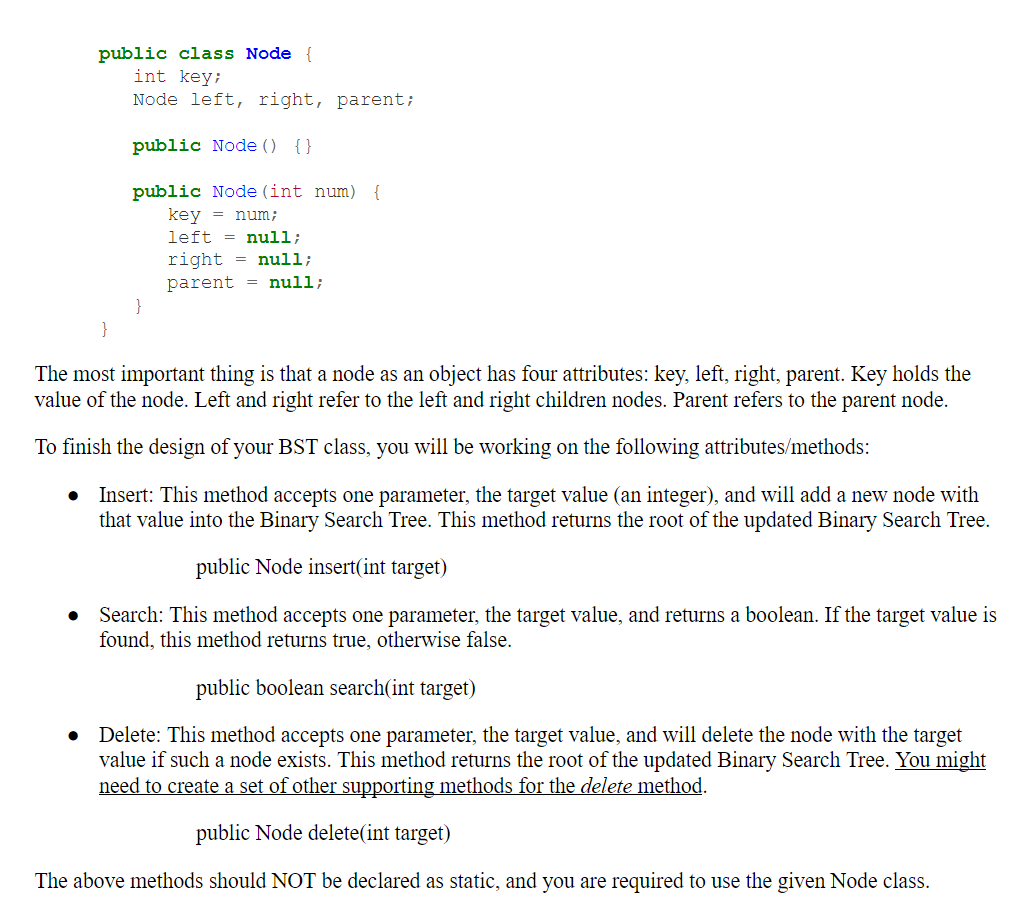Base of class Node public class Node { int key; Node left, right, parent; public Node() {} public Node(int num) { key = num; left = null; right = null; parent = null; } } Base of class BST import java.util.*; class BST { // do not change this private Node root; private ArrayList data; // DO NOT MODIFY THIS METHOD public BST() { root = null; data = new ArrayList(0); } // DO NOT MODIFY THIS METHOD public ArrayList getData() { return data; } // DO NOT MODIFY THIS METHOD public void inOrderTraversal() { inOrderTraversal(root); } // DO NOT MODIFY THIS METHOD private void inOrderTraversal(Node node) { if (node != null) { inOrderTraversal(node.left); data.add(node.key); inOrderTraversal(node.right); } } // search public boolean search(int target) { // remove this line return false; } // insert public Node insert(int target) { // remove this line return root; } // note: you may need to implement several supporting methods for delete public Node delete(int target) { // remove this line return root; } // you are welcome to add any supporting methods }
OOPs
In today's technology-driven world, computer programming skills are in high demand. The object-oriented programming (OOP) approach is very much useful while designing and maintaining software programs. Object-oriented programming (OOP) is a basic programming paradigm that almost every developer has used at some stage in their career.
Constructor
The easiest way to think of a constructor in object-oriented programming (OOP) languages is:
I have been posting the same questions but they always come with the same answer that does not use the starting code given below. Please make sure to use the following code as a starting point.
Also, please make sure to use the same class name so that I don't get confused.
Please use the information in the screenshot to create a class called BST. The base of the code is given below.
Base of class Node
public class Node {
int key;
Node left, right, parent;
public Node() {}
public Node(int num) {
key = num;
left = null;
right = null;
parent = null;
}
}
Base of class BST
import java.util.*;
class BST {
// do not change this
private Node root;
private ArrayList<Integer> data;
// DO NOT MODIFY THIS METHOD
public BST() {
root = null;
data = new ArrayList<Integer>(0);
}
// DO NOT MODIFY THIS METHOD
public ArrayList<Integer> getData() {
return data;
}
// DO NOT MODIFY THIS METHOD
public void inOrderTraversal() {
inOrderTraversal(root);
}
// DO NOT MODIFY THIS METHOD
private void inOrderTraversal(Node node) {
if (node != null) {
inOrderTraversal(node.left);
data.add(node.key);
inOrderTraversal(node.right);
}
}
// search
public boolean search(int target) {
// remove this line
return false;
}
// insert
public Node insert(int target) {
// remove this line
return root;
}
// note: you may need to implement several supporting methods for delete
public Node delete(int target) {
// remove this line
return root;
}
// you are welcome to add any supporting methods
}

Step by step
Solved in 2 steps with 2 images









